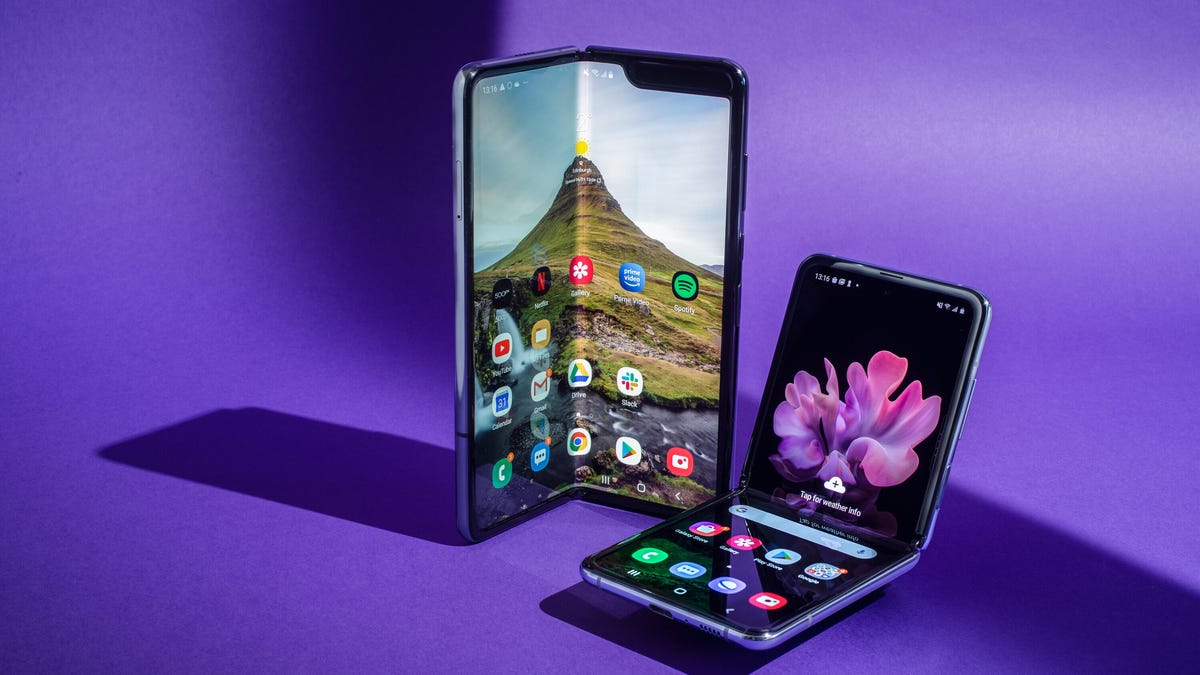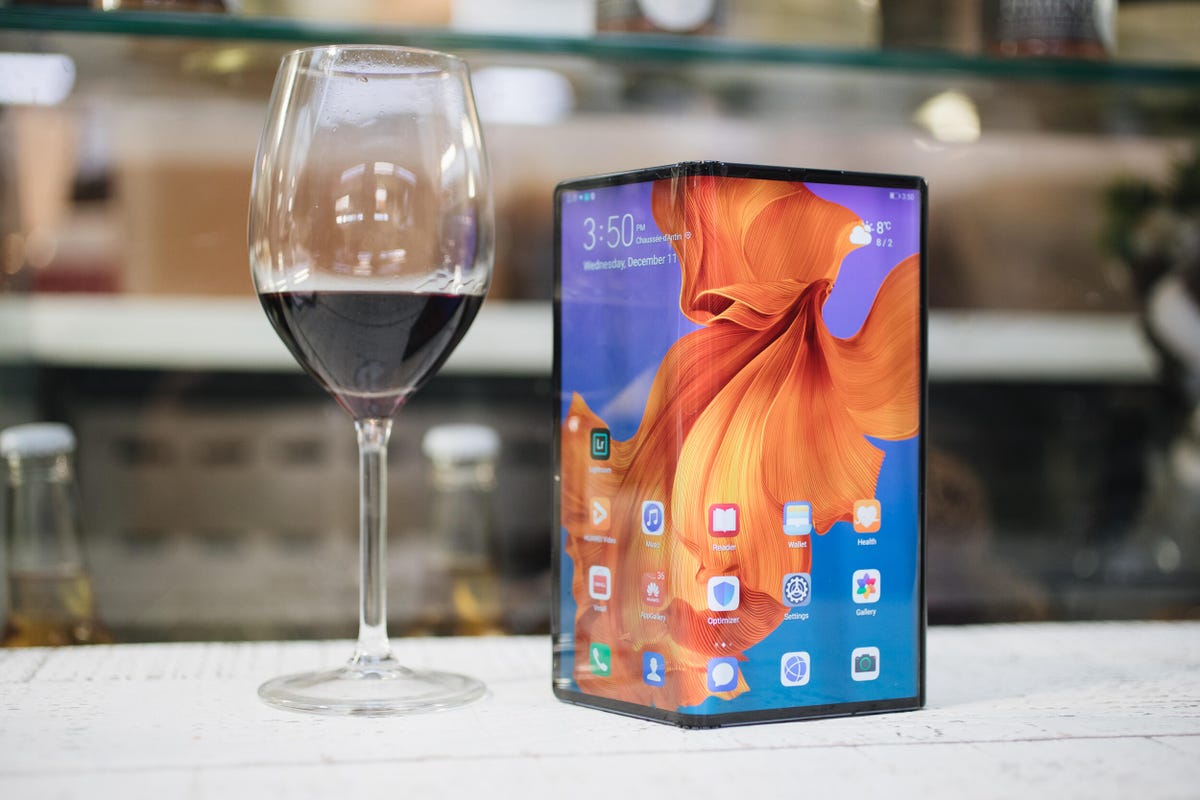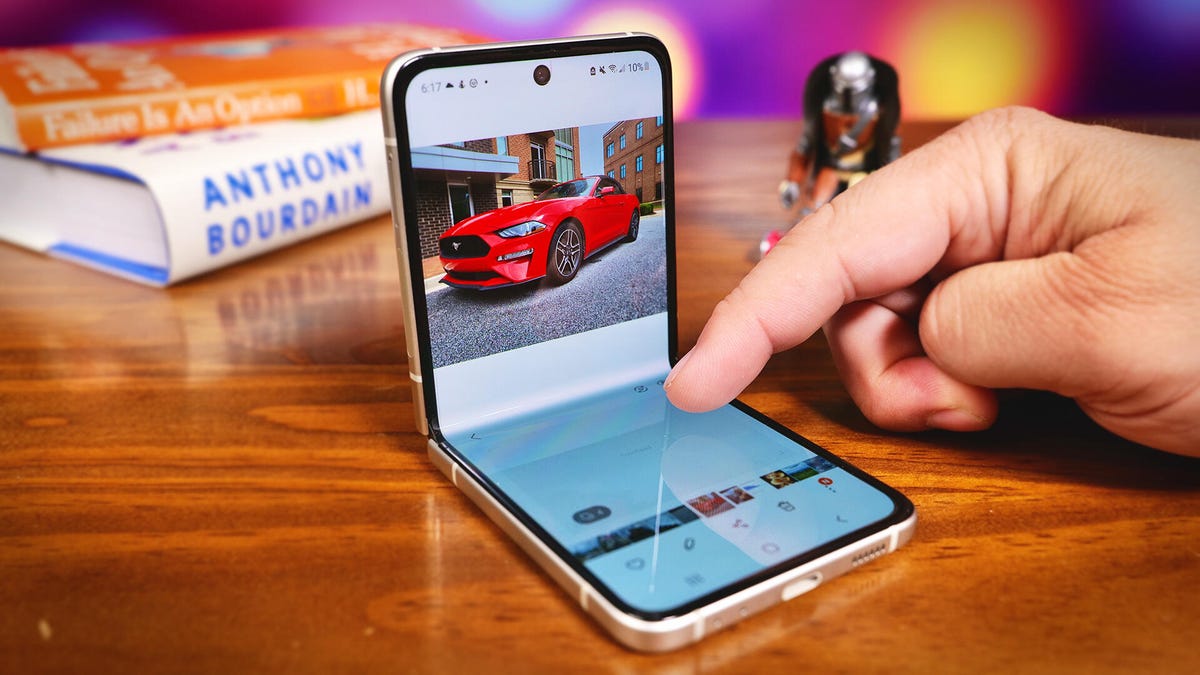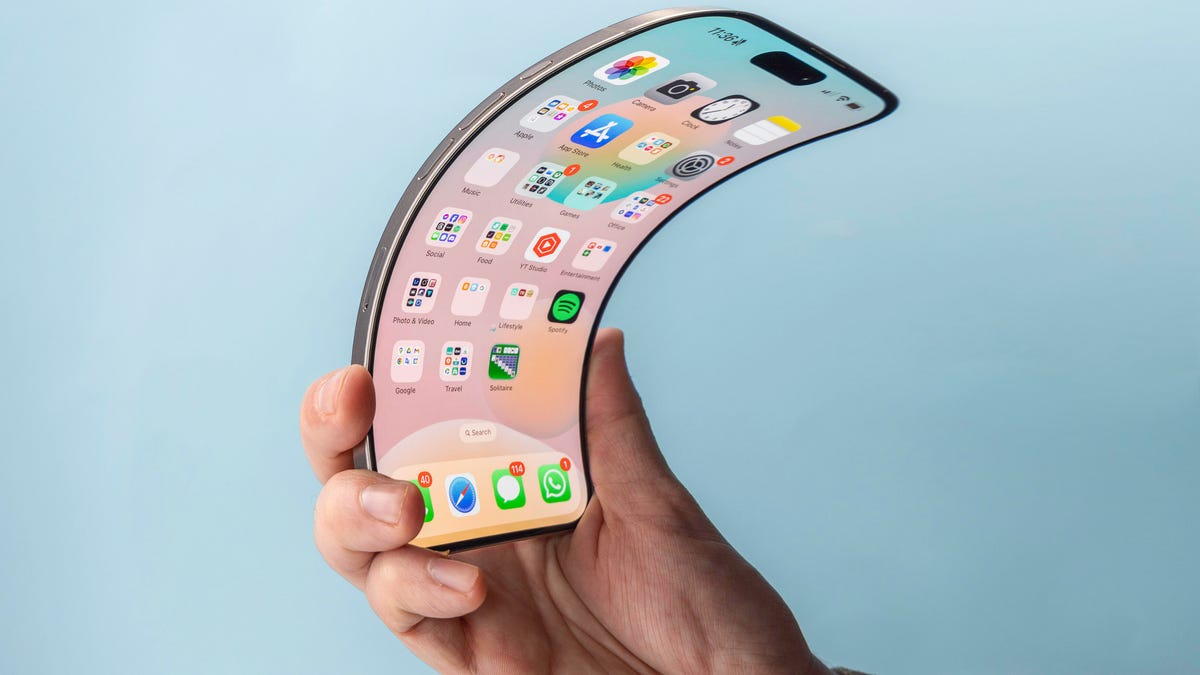Technologies
Google’s Pixel Fold Can Make Foldable Phones Exciting Again
Commentary: Foldable phones are disappointing, but Google’s Pixel Fold could change that. Here’s how.

Back in 2021 I wrote that foldable phones were disappointing, providing little to no revolution in how we use our phones on a daily basis, beyond the novelty of a screen that bends. They’re perfectly fine. But once you get over the initial fun of the fold, they’re really just another Android phone. The problem is that with less common sizes and aspect ratios being used on today’s foldables, apps and games don’t natively run properly. The audience is small, and developers don’t have the motivation to put in the time, effort and cost to develop their apps for odd shapes and sizes.
But Google might change that soon enough, with a rumored foldable Pixel phone that could appear at Google I/O in May. The company is in a unique spot to address software concerns while creating compelling phone hardware that doesn’t break the bank.
To be clear, I do like foldable phones. I particularly like the larger «book fold» models like the Samsung Galaxy Z Fold 4 and Honor Magic Vs, which transform from a regular-sized phone into an almost tablet-sized device, providing more screen space for videos, games and documents. I remember when I got the first-generation Galaxy Fold and felt genuinely excited at seeing the screen bend in the middle. And I remember the various strangers who would stop and ask to see it when I used it in public — with one bartender so entranced with the demo I gave that he returned the favor with a free beer. Score.


The bigger internal display of the Galaxy Z Fold series is great for watching videos.
Andrew Lanxon/CNETRead more: Best Foldable Phones to Buy in 2023
But the software is still where folding phones lag behind. Android is designed primarily for regular candybar smartphones, which are commonly around 6 inches to 6.8 inches in size and have standard aspect ratios like 16:9. In other words, phones like the Galaxy S23 Ultra or Pixel 7 Pro take full advantage of Android, and app developers design their apps for these same form factors. Why? Because they’re the most commonly used sizes, and therefore their apps will be optimized for the widest number of devices.
Android 12L and 13 address some of the sizing issues, but not all apps are optimized and either leave too much blank screen space or must stretch awkwardly to fit the screen. The Galaxy Z Fold 4, for example, has a tall and narrow 23.1:9 aspect ratio on the outside and a more square 21.6:18 aspect for the inner display — two nonstandard sizes that developers need to account for. And that’s just one device.


Huawei’s outward-folding Mate X was one of the earlier folding phones we saw.
Andrew Lanxon/CNETIt’s the same Android fragmentation issue that has plagued the platform since the beginning: Too many different devices means it’s difficult for developers to create for. Apple’s strategy of having fewer display sizes and almost identical aspect ratios has meant it’s typically been the easier platform for developers to work on. But Google has worked hard over the years to make Android an easier field on which to play, and it could do the same for foldables.
So could a folding Pixel phone be just another device for developers to struggle with? Perhaps not. If Google is committed to folding screen technology in its product lineup, then it’s safe to assume that we will see some key updates in Android that are specifically tailored to folding phones and different form factors. I’d like to see software that does a better job of automatically resizing apps, dual-screening when using a large display like the Z Fold 4’s or building more tricks into default apps that take advantage of inner and outer displays.


The tall and narrow dimensions of the Galaxy Z Flip present another dilemma for developers.
Patrick Holland/CNETMoreover, Google will likely work more closely with its key developer partners like Samsung, helping them not only optimize their existing apps for folding devices, but also create entirely new ones that can only be done with phones of this type. These partnerships will be crucial to helping Google create a compelling first-generation foldable, especially since non-folding Pixel phones account for just over 2% of smartphone market share in the US, according to analytics firm StatCounter. By comparison, Samsung has almost 30% share in the US.
Pixel phones tend to offer an excellent Android experience packaged in good hardware that costs hundreds less than flagship iPhone or Galaxy S phones. Google partnerships will be key to getting a Pixel foldable off the ground at an affordable price. A cheaper price is essential to getting a larger audience that would incentivize developers to create more fold-centric apps.
There are a lot of «ifs» and «coulds,» and we don’t know for sure if Google will launch a foldable. We also don’t know whether Google has a strategy in place to encourage adoption by working with software developers. Google will also have to rely on more than just its recognizable name to catapult the category into the big leagues. Let’s not forget that Microsoft’s Surface Duo 2 isn’t exactly ubiquitous, and neither is Samsung’s Galaxy Z Fold.
But I’m remaining hopeful, if only because I need to be. Standard smartphones have become increasingly dull and repetitive. For someone who writes about phones for a living, that’s a problem. Foldables present an opportunity to do things in a different and more exciting way, but it will be up to Google whether or not the category flourishes.
Technologies
Today’s NYT Strands Hints, Answers and Help for Nov. 27 #634
Here are hints and answers for the NYT Strands puzzle for Nov. 27, No. 634.

Looking for the most recent Strands answer? Click here for our daily Strands hints, as well as our daily answers and hints for The New York Times Mini Crossword, Wordle, Connections and Connections: Sports Edition puzzles.
Today’s NYT Strands puzzle has a holiday theme. Some of the answers are difficult to unscramble, so if you need hints and answers, read on.
I go into depth about the rules for Strands in this story.
If you’re looking for today’s Wordle, Connections and Mini Crossword answers, you can visit CNET’s NYT puzzle hints page.
Read more: NYT Connections Turns 1: These Are the 5 Toughest Puzzles So Far
Hint for today’s Strands puzzle
Today’s Strands theme is: With gratitude.
If that doesn’t help you, here’s a clue: Today’s the day.
Clue words to unlock in-game hints
Your goal is to find hidden words that fit the puzzle’s theme. If you’re stuck, find any words you can. Every time you find three words of four letters or more, Strands will reveal one of the theme words. These are the words I used to get those hints but any words of four or more letters that you find will work:
- MALE, MALES, DIAL, THEY, HONK, WRIT, ENDS, HEAL
Answers for today’s Strands puzzle
These are the answers that tie into the theme. The goal of the puzzle is to find them all, including the spangram, a theme word that reaches from one side of the puzzle to the other. When you have all of them (I originally thought there were always eight but learned that the number can vary), every letter on the board will be used. Here are the nonspangram answers:
- FOOD, LIFE, FAMILY, FRIENDS, HEALTH, WORK, COMMUNITY
Today’s Strands spangram
Today’s Strands spangram is THANKFUL. To find it, start with the T that’s five letters down on the far-left row, and wind up and across.
Toughest Strands puzzles
Here are some of the Strands topics I’ve found to be the toughest in recent weeks.
#1: Dated slang, Jan. 21. Maybe you didn’t even use this lingo when it was cool. Toughest word: PHAT.
#2: Thar she blows! Jan.15. I guess marine biologists might ace this one. Toughest word: BALEEN or RIGHT.
#3: Off the hook, Jan. 9. Similar to the Jan. 15 puzzle in that it helps to know a lot about sea creatures. Sorry, Charlie. Toughest word: BIGEYE or SKIPJACK.
Technologies
Google’s Pixel Buds Pro 2 Just Hit a New Low of $134 in Amazon’s Black Friday Sale
We’ve never seen these earbuds fall this low, but we don’t expect this deal to last for long.
If you’re in the market for a new pair of earbuds this Black Friday, now’s your chance to get them. We’ve found a great discount on the Google Pixel Buds Pro 2 thanks to the Cyber Week festivities. They’re among the best wireless earbuds as our top pick for Android users and, at just $134, they’re a bargain to boot.
That’s a new low for these earbuds, but do be aware that it only applies to the moonstone color currently. That could change at any moment, though, so make sure to check the price of the other colors if moonstone isn’t your thing. Either way, we don’t expect this price to last for long, so order sooner rather than later.
The earbuds provide noticeably improved sound quality and noise cancellation compared to their predecessor. They’re built with Google’s powerful Tensor A1 chip and designed to offer rich, immersive sound. It’s the first time a Google Tensor chip has been featured in any earbuds and the result is robust active noise cancellation and advanced sound.
The Google Pixel Buds Pro 2 earbuds deliver deep bass with their built-in 11 mm drivers and a new high-frequency chamber for smoother treble. CNET’s audio expert David Carnoy noted that compared to the original Pixel Buds Pro, «there’s more depth and richness to the sound with better overall definition and extension.» Read his full review of the Pixel Buds Pro 2 to get the full lowdown.
These buds also got a design upgrade, with Google making them 27% smaller and 24% lighter to securely fit even more ear types. If you want to wear them during workouts, there’s a twist-to-adjust stabilizer to help lock your earbuds in place while you’re moving around and sweating.
There’s also a conversation detection feature that pauses your music and switches your earbuds to the transparency mode if you start talking. And with an impressive 30-hour battery life, you can listen to all your favorite songs, audiobooks and podcasts for hours on end without having to recharge.
HEADPHONE DEALS OF THE WEEK
-
$248 (save $152)
-
$170 (save $181)
-
$298 (save $131)
-
$199 (save $150)
Why this deal matters
At $134, these earbuds are a great buy thanks to advanced active noise cancellation, impressive sound quality and a lengthy battery life. The current deal makes the Pixel Buds Pro 2 earbuds cheaper than ever. But the deal won’t be around for long, so act fast if you want to take advantage of this awesome discount.
Join Our Daily Deals Text Group!
Get hand-picked deals from CNET shopping experts straight to your phone.
By signing up, you confirm you are 16+ and agree to receive recurring marketing messages at the phone number provided. Consent is not a condition of purchase. Reply STOP to unsubscribe. Msg & data rates may apply. View our Privacy Policy and Terms of Use.
Technologies
Apple Desperately Needs to Launch a Foldable iPhone Flip Next Year
Commentary: Apple is the only major phone company without a folding phone. That needs to change in 2026.

Apple’s iPhone 17 came and went and while we certainly love the iPhone 17 Pro and its vibrant cosmic orange color, I can’t help but be disappointed that the long-rumored foldable iPhone Flip wasn’t part of the company’s September launch event. Most Android phone-makers, including Samsung, Google, Motorola, OnePlus, Xiaomi and Honor are multiple generations into their own folding phone lineups, and it’s beginning to feel like Apple is late to the party. That might be a problem.
Apple dominates in the premium phone category, but foldables — which fit into the premium space in terms of price — are already nipping at its heels, with Motorola telling CNET that 20% of customers buying its Razr foldable jumped ship from Apple. Meanwhile, Samsung is in the seventh generation of its Flip and Fold series. As Lisa Eadicicco discovered during a visit to Seoul, «foldables are everywhere» in Samsung’s home country of South Korea.
With nearly every major Android phone-maker entering the foldable market, Apple risks losing potential customers. It also runs the risk of letting a rival like Samsung become the go-to name for foldables, which could make it harder for Apple to make an impact if it eventually launches its own device. Furthermore, early adopters drawn to foldable tech may be too entrenched in the Android ecosystem by the time Apple’s phone arrives to want to switch to iOS.
Apple is unlikely to be worried. It’s estimated that around 20 million foldables from all manufacturers were sold worldwide in 2023, while Apple reportedly sold 26.5 million iPhone 14 Pro Max handsets in the first half of that year alone. In 2024, foldable sales were flat — and 2025 isn’t fairing much better, according to analysts at CounterPoint Research, although Samsung did report record numbers of preorders for its latest foldable. Clearly, Apple feels it has yet to miss the boat.
Apple has always found success in biding its time, observing the industry and launching its own take on a product when it’s ready. Apple didn’t invent phones, tablets, smartwatches or computers, but it found ways to take existing products and make them more useful, more valuable in day-to-day life and — dare I say — more exciting. It’s why the iPhone, iPad, Apple Watch and Mac lines dominate the market today.
For me, I need to see Apple’s take on the foldable phone. I’ve written before about how disappointed I am in foldables. I’ve been a mobile reporter for over 14 years and phones have become increasingly dull as they’ve converged to become slight variations on the same rectangular slab.
Read more: Best Flip Phone for 2025
Foldables promised something new, something innovative, something that briefly sparked some excitement in me, but several years in, that excitement has dwindled to the point of being extinguished. They are fine products and while I like the novelty of a screen that bends, they’re not a revolution in how we interact with our phones. Not in the way that the arrival of the touchscreen was when we were still pushing buttons to type out texts.
I did hope that Google’s Pixel Fold would be the phone to catapult the foldable forward, and while the recent Pixel 10 Pro Fold — the second generation of Google’s foldable — does offer some great updates, it still doesn’t offer any kind of revolution. Instead, it feels more like a «me too» move from Google. Ditto for the OnePlus Open. So I’m left instead to look toward Apple, a company with a track record for product revolutions, to create a new take on the genre that genuinely drives forward how we use our phones.
That innovation won’t just come from the product design. Apple works closely with its third-party software developers, and it’s that input that would help a folding iPhone become genuinely useful. My biggest complaint around foldables right now is that while the hardware is decent, the devices are essentially just running standard versions of Android with a handful of UI tweaks thrown in. They’re regular phones that just happen to bend.
Few Android developers are embracing the folding format, and it’s not difficult to see why; the users aren’t there in sufficient numbers yet to justify the time and expense to adapt their software across a variety of screen sizes. The multiple folding formats already available mean Android foldables face the same fragmentation issue that has plagued the platform since the beginning. Android-based foldables are simply a more difficult platform for developers to build for than regular phones. Apple would be able to change that, as it proved with the iPhone and iPad.
Given Apple’s close relationships with top-tier developers — not to mention its own vast developer team — I expect an eventual Apple foldable to offer innovations that make it more than just an iPhone that folds in half.
And I truly hope it does. I want to look forward to tech launches again. I want to feel excited to get a new gadget in my hands and feel that «wow» moment as I do something transformative for the first time.
In short, I don’t want to be bored by technology anymore. Apple, it’s over to you.
-

 Technologies3 года ago
Technologies3 года agoTech Companies Need to Be Held Accountable for Security, Experts Say
-

 Technologies3 года ago
Technologies3 года agoBest Handheld Game Console in 2023
-

 Technologies3 года ago
Technologies3 года agoTighten Up Your VR Game With the Best Head Straps for Quest 2
-

 Technologies4 года ago
Technologies4 года agoBlack Friday 2021: The best deals on TVs, headphones, kitchenware, and more
-

 Technologies4 года ago
Technologies4 года agoVerum, Wickr and Threema: next generation secured messengers
-

 Technologies4 года ago
Technologies4 года agoGoogle to require vaccinations as Silicon Valley rethinks return-to-office policies
-

 Technologies4 года ago
Technologies4 года agoOlivia Harlan Dekker for Verum Messenger
-

 Technologies4 года ago
Technologies4 года agoiPhone 13 event: How to watch Apple’s big announcement tomorrow
